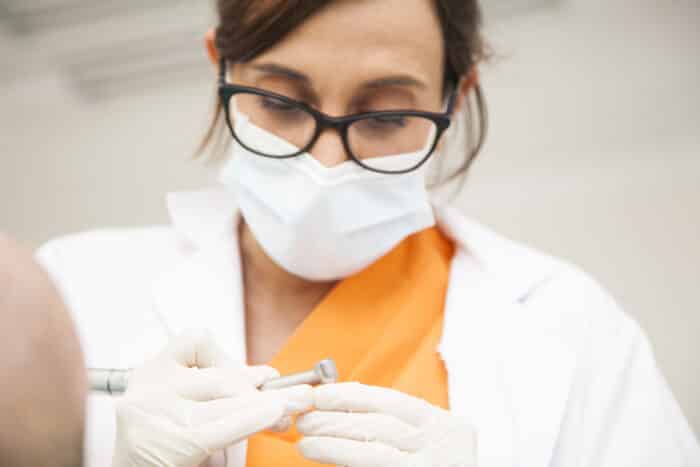Are you ready to kickstart your journey in the dental world?
If you’ve ever dreamed of being part of a dental team, helping folks sport their best smiles and oral health, you’re in the right place.
Welcome to our “Dental Assistant License Guide” – your all-in-one guide for not just a job, but an honest information leaflet for establishing a career in this rewarding field.
Being a dental assistant is more than just work; it’s a calling to back up dentists, calm patients, and keep dental practices running smoothly.
But before you jump into this exciting career, you might be wondering if becoming a dental assistant requires a license and if it does, how to get it.
We’ve got you covered with that too.
So, keep reading.
What is a Dental Assistant License?
Think of a Dental Assistant License as your pass to work in a dental office as a dental assistant. It’s like a thumbs-up from the experts that you’re ready to do the job.
In the USA, each state gives out these licenses, and the rules to get one might be a bit different depending on where you are.
See: What is a Dental Assistant
How to Get a Dental Assistant License
Now, coming to the main question that might be brewing in your mind, let’s take a look at the process of getting a dental assistant license. Don’t worry, it’s not as difficult as it sounds.
Here are the main steps you’ll need to follow to get your dental assistant license:
1. Education: First, you need to finish a dental assisting program that’s approved by your state. You can find these programs at community colleges, trade schools, or even online. Just make sure the program you choose matches your state’s education standards.
2. Hands-On Experience: In some places, you’ll have to get a certain number of hours of real-world experience in a dental office. Luckily, many of these hours can be earned while you’re in your educational program, so you learn by doing.
3. Certification: Many states want dental assistants to pass a special test. The Dental Assisting National Board (DANB) gives a test called the Certified Dental Assistant (CDA) exam, which is accepted in lots of states.
4. Application: Once you’ve finished your education and met any other state needs, you’ll need to apply to your state’s dental board. You’ll need to send them your transcripts, proof of your hands-on experience, and your test results.
5. Background Check: In some states, you might also need to go through a background check as part of the application.
6. Fees: Don’t forget about the application fees. Each state sets its own costs, so be sure to look up your state dental board’s website to find out how much you’ll need to pay.
Read: Where can a Dental Assistant work
Renewing Dental Assistant License
To keep your license valid, you’ll need to renew it regularly.
The exact process can vary from one state to another, but it typically involves these steps:
1. Continuing Education: In most states, you must complete a certain number of hours of additional education during each renewal period. This helps you stay up-to-date with the latest dental assisting techniques and knowledge.
2. Renewal Application: You’ll have to fill out a renewal application and provide any necessary documents to your state’s dental board.
3. Renewal Fee: Similar to when you first applied for your license, renewing it requires a fee.
How to Transfer a Dental Assistant License from One State to Another?
If you’re a dental assistant thinking about working in a different state, you’ll probably have to transfer your license.
Here’s how you can do that:
1. Check the Rules: Start by finding out what the new state’s requirements are for dental assistants. Each state can have its own rules and might ask for different qualifications or certifications.
2. Contact the Dental Board: Get in touch with the dental board in your current state and ask them for a “Letter of Verification” or “License Verification.” This paper shows that you’re currently licensed as a dental assistant.
3. Apply in the New State: Send in an application to the dental board in the new state, and don’t forget to include the Letter of Verification from your current state. You might also need to meet any extra requirements that the new state wants.
4. Background Check: In some states, they might want to do a background check on you as part of the application process if you’re moving from out of state.
Conclusion
Always remember that your dental assistant license is your ticket to the world of dentistry.
We hope this guide highlighted how important getting a dental license is for you to become a successful dental assistant to become successful, and how to get one.
Related Resources:
- Dental Assistant Salary
- Dental Assistant Job Description
- Pediatric Dental Assistant
- Travel Dental Assistant
- Is Dental Assistant a Good Career?
- What education is required to be a dental assistant?
- How much is dental assistant school
- Entry-Level Dental Assistant
- Dental Assistant Vs Medical Assistant
- Is Dental Assistant School Hard?
- Is Dental Assistant a Good Job?
- Dental Assistant Instrument Names
- Dental Assistant Internship & Externship
- Lead Dental Assistant
- Dental Assistant Degree
- Dental Assistant Certificate
Related Articles
-
How to Be Successful in College in 2022 – 7 Simple Tips to Succeed
-
How Do Scholarships Work? Read This First…Truth is Shocking
-
7 Best College Majors 2024: What Should I Major In?
-
How to Choose a College – 10 Things You Must Consider in 2024
-
Why Go to College? Top 13 Benefits for Adult Students in 2022
-
Top 5 Best Alternatives to Community College for 2024







